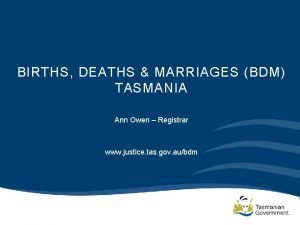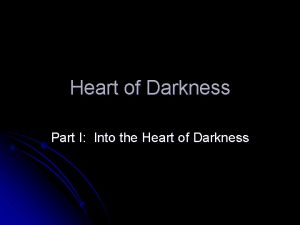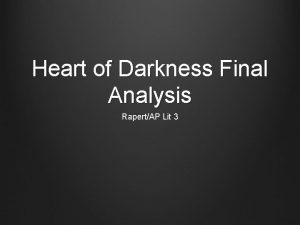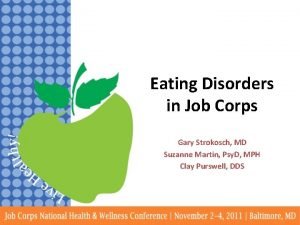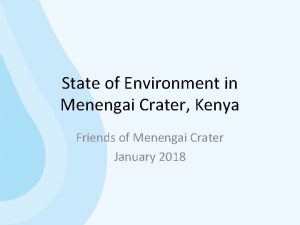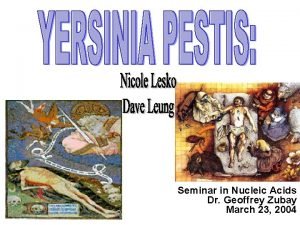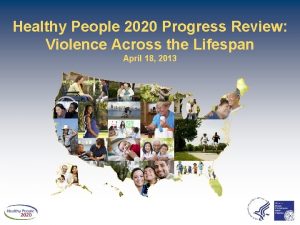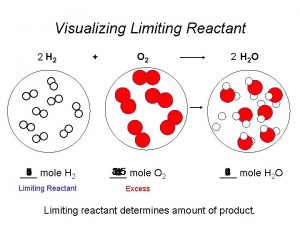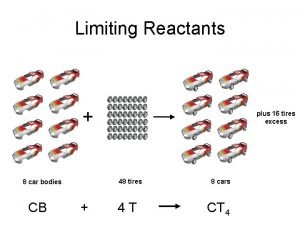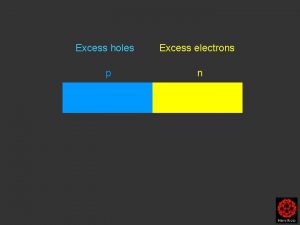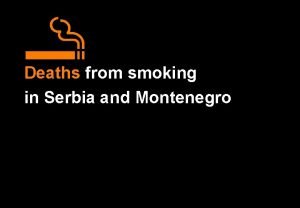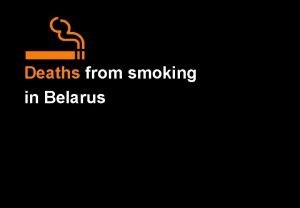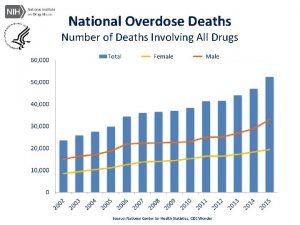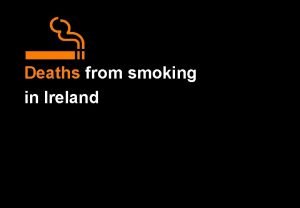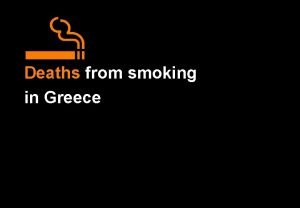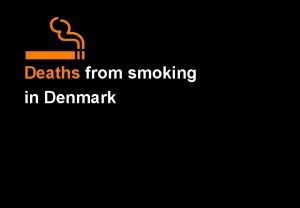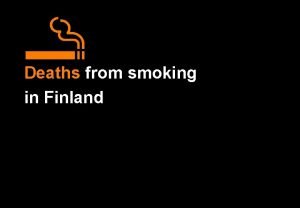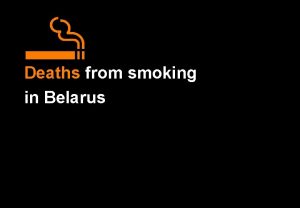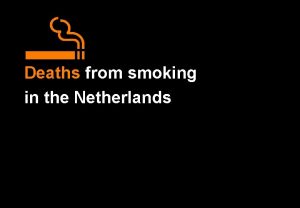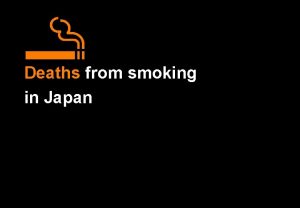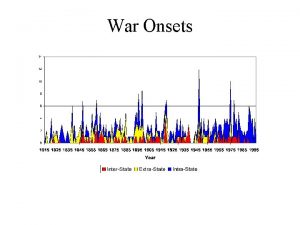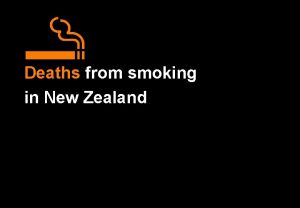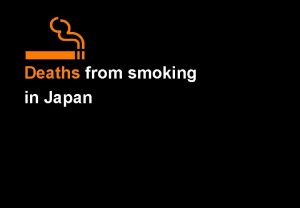Excess Winter Deaths and the winter of 201718























- Slides: 23

Excess Winter Deaths and the winter of 2017/18 Information for Local Authorities PHE Extreme Events and Health Protection

Aims of this slide pack This slide pack is intended for local authority (LA) staff, primarily those working in public health. The aims of this slide pack are : 1. to raise awareness of the health impacts of cold weather 2. to be a resource which can be utilised to engage with stakeholders 3. to aid in planning and decision-making for the forthcoming winter. The slides give an overview of the evidence base, epidemiology of excess winter deaths and recommendations for action, with particular reference to the winter of 2017/18. Links to additional information and resources are also provided. We would encourage users to combine the information presented here with local data which can be accessed using the links in slides 22 and 23. 2 Winter Deaths and the winter of 2017/18 – Information for LA

Contents Background (slides 4 -9) • Health impacts of cold weather • Who is affected Data for the winter of 2017/18 (slides 10 -18) • Overview of the winter of 2017/18 • Excess winter deaths in the winter of 2017/18 • When did the deaths occur • Who was affected • What were the causes of death • Which regions were affected Implications (slides 19 -23) • Preventing Excess Winter Deaths (EWD) • What does this means for the NHS? • Media messages and useful resources 3 Winter Deaths and the winter of 2017/18 – Information for LA

Deaths over the year • • More people die in the winter than in the summer Deaths tends to peak in January, commonly the coldest month of the year in England Wales Number of deaths 70000 20 18 16 14 12 10 8 6 4 2 0 60000 50000 40000 30000 20000 10000 Ju ly ne Ju ay M ril Ap ch ar M ua r y y nu ar Ja Fe br r D ec em be r be em ov N r er ob O ct em be pt Se Au gu st 0 Month of death 4 Count by month 2017/18 Five-year average mean monthly deaths Mean monthly temperature (2017/18) Five-year average mean monthly temperature Winter Deaths and the winter of 2017/18 – Information for LA Temperature (o. C) Mean daily deaths and temperature by month, 2017/18 and five-year average , England Wales

How does cold weather impact health – physiology? The human body responds in several different ways to exposure to cold weather, even at temperatures which might be considered relatively mild (see Slide 7). Exposure to cold temperatures has a range of physiological effects including: • • • increased blood pressure increased risk of clotting suppression of the immune system diminished capacity of the lungs to fight off infection increased airway constriction and mucus production in the lungs 2 5 Winter Deaths and the winter of 2017/18 – Information for LA

How does cold weather impact health – morbidity and mortality? Although exposure to extreme cold can kill directly through hypothermia, this is not the main cause of cold related illness and death 2. The health impacts of cold weather can have direct and indirect effects Direct health effects Indirect health effects heart attack mental health effects from depression stroke respiratory disease influenza falls and injuries hypothermia 6 reduced educational and employment attainment risk of carbon monoxide poisoning Winter Deaths and the winter of 2017/18 – Information for LA

What happens during cold weather? Deaths caused by cardiovascular conditions peak first followed by stroke and then respiratory. Reference: 2009 Annual Report of the Chief Medical Officer. Original source: Donaldson GC, Keatinge WR. Early increases in ischaemic heart disease mortality dissociated from and later changes associated with respiratory mortality after cold weather in south east England. J Epidemiol Community Health. 1997 Dec; 51(6): 643 -8. Snow and ice also cause: • disruption to service provision • reduction in access to essential services • increase in the risk of falls and injuries 7 Winter Deaths and the winter of 2017/18 – Information for LA

Which temperatures have an impact? • The health impacts of cold weather can be seen even at temperatures which might be considered relatively mild • Although the risk of death increases as temperatures fall, the higher frequency of days at moderate temperatures in an average winter means the greatest health burden in absolute numbers of deaths, occurs at more moderate temperatures 2 8 Temperature Health Impacts 18 o. C minimal risks to health for a sedentary person wearing suitable clothing Under 18 o. C may increase blood pressure and risk of cardiovascular disease Under 16 o. C may diminish resistance to respiratory diseases 4 – 8 o. C increased risk of death observed at population level At or below 5 o. C high risk of hypothermia Winter Deaths and the winter of 2017/18 – Information for LA

Who is affected? • • EWDs are seen throughout England – all regions are affected Whilst the burden of EWDs is primarily seen in older age groups, EWDs are seen in all age groups EWDs represent an important health inequality – people who experience greater socioeconomic deprivation are more likely to be affected There a number of factors which contribute to EWDs: Household income Seasonal factors: weather, flu Attitudes to cold and associated behaviours Individual vulnerability to health effects of cold Housing and economic factors Cost of fuel Energy efficiency of the home 9 Winter Deaths and the winter of 2017/18 – Information for LA

Measuring winter deaths Measure Description Main advantages and disadvantages Good for looking at specific cold spells Counts Excess Winter Deaths (EWD) Simple counts of deaths by day, week, or month over the year Compares the number of deaths which occur during the ‘winter months’ in any given year with the ‘non-winter months’. Winter months are classified as November to March. EWD = winter deaths - average non-winter deaths Excess winter mortality (EWM) index Similar to EWD but provides a measure of EWD relative to non-winter deaths in a particular population. EWM index = (EWD / average non-winter deaths) x 100 Doesn’t provide any measure of the impact of winter overall Doesn’t allow direct comparisons i. e. not standardised across different populations Provides an estimate of the overall impact of winter on number of deaths in a given year Doesn’t provide detail of when the deaths occurred during the winter (i. e. impact of specific cold spells like Beast from the East). Doesn’t allow for the impact of cold weather outside of the ‘winter months’ Doesn’t allow direct comparisons i. e. not standardised across different populations Allows for crude comparison between groups with difference population sizes for example different sexes, age groups, and regions Not as easy to interpret as EWD Further information on measures of winter deaths is provided in the ONS report – see references and useful documents section 10 Winter Deaths and the winter of 2017/18 – Information for LA

Why are we focusing on the winter of 2017/18? It is the latest year for which we have comprehensive data and, the winter of 2017/18 had a significant impact on health due to both very cold temperatures and circulating flu. The cold • The average winter temperature for 2017/18 was the coldest in 5 years • A particularly cold spell occurred in late February 2018 – ‘the Beast from the East’ The flu • Although uptake of the influenza vaccine was higher compared with 2016/17, overall the vaccine was less effective in those aged 65 years and over (10. 1% effective) compared to younger age groups • Co-circulation of influenza A (H 3 N 2) and influenza B was observed impacting predominantly older adults with increased care home outbreaks 11 Winter Deaths and the winter of 2017/18 – Information for LA

How many EWDs were there during the 2017/18 winter? • In the 2017/18 winter period, there were an estimated 50, 100 excess winter deaths (EWD) in England Wales • This compares to an average of around 30, 300 EWDs annually over the past 5 years • The number of EWDs in 2017/18 was the highest recorded since the winter of 1975/76 Excess winter deaths (number) Excess winter deaths by winter season, England Wales, 2008/09 - 2017/18 60000 50000 40000 30000 20000 10000 0 2008/09 2009/10 2010/11 2011/12 2012/13 2013/14 Winter season 12 Winter Deaths and the winter of 2017/18 – Information for LA 2014/15 2015/16 2016/17 2017/18

When did the deaths occur and how is this different from previous years? • The usual peak in number of deaths was seen in December and January, although this was higher in 2017/18 than the average for the previous 5 years • An additional peak in number of deaths was seen in late February/early March, coinciding with very cold weather caused by the Beast from the East Mean number of daily deaths by ISO week, England Wales, 2017/18 and previous fiveyear average 2500 Beast from the East Number of deaths 2000 1500 2017/18 Five-year average 1000 Grey shaded area corresponds to the ‘winter months’ 500 0 32 34 36 38 40 42 44 46 48 50 52 2 4 6 8 10 12 14 16 18 20 22 24 26 28 30 International Organization for Standardization (ISO) week number 13 Winter Deaths and the winter of 2017/18 – Information for LA

Who was most affected by the 2017/18 winter? • The majority of EWDs occurred in the older age groups (80% were in those aged 75+) with females aged 85+ years being most affected • Note: due to differences in life-expectancy, there are more women aged 85+ than men. Therefore Excess Winter Mortality (EWM) index provides a better comparison of relative impact between male/female and age groups (right-hand figure) EWD by age and sex, England Wales, 2017/18 EWM index by age and sex, England Wales, 2017/18 85+ Age group (years) 85+ 75– 84 65– 74 0– 64 10, 000 5, 000 10, 000 15, 000 Excess winter deaths Male 14 Female Winter Deaths and the winter of 2017/18 – Information for LA 40 30 20 10 20 Excess winter mortality index Male Female 30 40

How is this different from previous years? • EWM index was higher in 2017/18 than the five-year average EWM index for all age groups, for both men and women, indicating that the impact of winter in 2017/18 was greater than in recent years • EWM index in 2017/18 for males aged 0 -64 years was more than double the five-year average EWM index for females, 5 year average and 2017/18, England Wales 50 50 45 45 40 40 35 35 EWM index for males, 5 year average and 2017/18, England Wales 30 25 20 15 10 10 5 5 0 0 0– 64 65– 74 75– 84 85+ Age group (years) Five-year average EWM index 15 EWM index 2017/18 Winter Deaths and the winter of 2017/18 – Information for LA 0– 64 65– 74 75– 84 85+ Age group (years) Five-year average EWM index 2017/18

What were the causes of EWD in 2017/18? • The majority of EWDs were caused by either circulatory diseases, respiratory diseases, or dementia and Alzheimer’s disease • Over one third of deaths were caused by respiratory disease (accounting for 17, 400 EWDs in 2017/18) EWD by underlying cause of death, 2017/18, England Wales Excess Winter Deaths 20000 18000 16000 14000 12000 10000 8000 6000 4000 2000 0 Circulatory diseases Respiratory diseases Cause of death 16 Winter Deaths and the winter of 2017/18 – Information for LA Dementia and Alzheimer's disease

How is this different from previous years? • EWM index was higher for the winter of 2017/18 than the 5 year average for all the 3 major underlying causes of death • The biggest increase in EWM index was seen for deaths from respiratory diseases EWM index by cause, England Wales, 5 year average and 2017/18 100 90 80 70 60 50 40 30 20 10 0 Circulatory diseases Respiratory diseases Dementia and Alzheimer's disease Cause of death Five-year average EWM index 17 EWM Index 2017/18 Winter Deaths and the winter of 2017/18 – Information for LA

Which regions were most affected? • Overall, the EWM index for all English regions has increased for 2 consecutive periods (between 2015 to 2016, and 2017 to 2018) • In England, the North East experienced the highest EWM index in 2017/18, with East of England, the North West, and West Midlands, also experienced a higher EWM index than the rest of the country • However, the EWM index is a crude indicator so direct comparison between years or across regions should be done with caution EWM index for regions of England in Wales, between 2015 to 2016 and 2017 to 2018 Reference: Office for National Statistics. Excess winter mortality in England Wales: 2017 to 2018 (provisional) and 2016 to 17 (final). Available at: https: //www. ons. gov. uk/peoplepopulationandcommunity/birthsdeathsandmarriages/deaths/bulletins/excesswintermortalityinenglandandwales/2017 to 2018 provisionaland 2 016 to 2017 final 18 Winter Deaths and the winter of 2017/18 – Information for LA

Preventing EWDs The NICE guidelines (NG 6) for reducing the risk of death and ill health associated with living in a cold home aims to improve the health and wellbeing of people vulnerable to the cold, further detail is provided on the next slide. The Cold Weather Plan for England recommends a series of steps to reduce the risks to health from cold weather for: • the NHS, Local Authorities, social care, and other public agencies • professionals working with people at risk • individuals, local communities and voluntary groups Near real-time data is also produced throughout the year to support planning and prevention of EWDs. Links to these are provided in Appendix 1 (Slide 21). 19 Winter Deaths and the winter of 2017/18 – Information for LA

What can LAs do? A summary of the recommendations from the NICE guidance is outlined here. For further information see NICE guidance NG 6 Develop a strategy Ensure buildings meet standards Train people to help individuals whose homes may be too cold • Social care practitioners • Housing professionals • Faith and voluntary sector workers • Heating engineers, meter installers and those providing building insulation 20 Raise awareness about how to keep warm at home The health consequences of living in a cold home should be included in the JSNA process Identify people at risk Reducing EWDs Discharge vulnerable people from care settings to a warm home Winter Deaths and the winter of 2017/18 – Information for LA Provide a single-pointof-contact for help Make Every Contact Count Requires collaboration of primary health and home care practitioners, and relevant LA departments Where professionals and public can go to get more information and support Health and home care practitioners, and nonhealth and social care workers should assess the heating needs of people who use their services

Key public health messages for the public and media this winter Below are some lines which can be used when dealing with media and other enquiries this winter: • Severe cold weather can be dangerous, especially for the very young or very old or those with chronic disease. • Advice on how to reduce the risk either for yourself or somebody you know can be obtained from the winter health pages at NHS. uk (www. nhs. uk) or from your local chemist. • If you are worried about your health or that of somebody you know, ring NHS 111. • Make sure that you stay warm. If going outside make sure you dress appropriately. • If indoors, make sure that you keep your heating to the right temperature; heating your home to at least 18 o. C in winter poses minimal risk to your health when you are wearing suitable clothing. • If there is anyone you know who might be at special risk, for example, an older person living on their own, make sure they know what to do to stay warm and are well stocked with food and medications. 21 Winter Deaths and the winter of 2017/18 – Information for LA

Appendix 1: Available data PHE Real Time Syndromic Surveillance coordinates several national syndromic systems and provides information on weekly trends in diseases and healthcare usage, including: • NHS 111 enquiries • GP in-hours and out-of-hours consultations • emergency department attendances • ambulance call-outs Available at: https: //www. gov. uk/government/publications/syndromic-surveillance-weeklysummaries-for-2019 The Weekly National Flu Reports provide national-level data on consultations for influenzalike-illness, reported outbreaks, and laboratory reports of influenza (produced weekly during flu season) Available at: https: //www. gov. uk/government/collections/weekly-national-flu-reports#2018 -to 2019 -season Weekly Infectious Intestinal Disease Activity bulletins provide regional-level data on consultation for gastroenteritis, reported outbreaks, and laboratory reports for viral and bacterial gastroenteritis. These are available by contacting your local PHE Health Protection Team. 22 Winter Deaths and the winter of 2017/18 – Information for LA

Appendix 2: References and useful documents 1. Office for National Statistics report: Excess winter mortality in England Wales: 2017 to 2018 (provisional) and 2016 to 2017 (final) https: //www. ons. gov. uk/peoplepopulationandcommunity/birthsdeathsandmarriages/deaths/b ulletins/excesswintermortalityinenglandandwales/2017 to 2018 provisionaland 2016 to 2017 final 2. PHE Cold Weather Plan for England (https: //www. gov. uk/government/collections/coldweather-plan-for-england) 3. NICE Guidelines (NG 6): Excess winter deaths and illness and the health risks associated with cold homes https: //www. nice. org. uk/guidance/ng 6 4. PHE Fingertips https: //fingertips. phe. org. uk/ 5. PHE Local Health http: //www. localhealth. org. uk/#l=en; v=map 15 6. PHE Homes for health https: //www. gov. uk/government/collections/housing-for-health 7. Help from your energy supplier: the Affordable Warmth Obligation https: //www. gov. uk/energy-company-obligation 8. Affordable warmth grants http: //www. affordablewarmthgrants. co. uk/ 9. NEA Action for Warm Homes https: //www. nea. org. uk/ 23 Winter Deaths and the winter of 2017/18 – Information for LA
 Tas bdm
Tas bdm Winter kommt winter kommt flocken fallen nieder
Winter kommt winter kommt flocken fallen nieder Winter kommt winter kommt flocken fallen nieder lied
Winter kommt winter kommt flocken fallen nieder lied Winter kommt winter kommt flocken fallen nieder
Winter kommt winter kommt flocken fallen nieder Negara yang terlibat perang dunia 2
Negara yang terlibat perang dunia 2 The heart of darkness summary
The heart of darkness summary Heart of darkness part 3 quotes
Heart of darkness part 3 quotes Bulimia cheeks before after
Bulimia cheeks before after Menengai crater deaths
Menengai crater deaths Dr abeer deaths
Dr abeer deaths Tobacco causes _______ of cancer deaths around the world. *
Tobacco causes _______ of cancer deaths around the world. * Crystal ballroom millennium biltmore hotel
Crystal ballroom millennium biltmore hotel Deaths from smoking
Deaths from smoking Clydebank blitz map
Clydebank blitz map World million deaths
World million deaths Lincoln interpreted his reelection as a mandate to
Lincoln interpreted his reelection as a mandate to 2020 motor vehicle deaths
2020 motor vehicle deaths West point graduate deaths
West point graduate deaths Visualizing the limiting reactant answer key
Visualizing the limiting reactant answer key Measures to correct excess and deficient demand
Measures to correct excess and deficient demand Limiting and excess reactants race car answers
Limiting and excess reactants race car answers Limiting reagent and excess reagent
Limiting reagent and excess reagent Excess reactant calculation
Excess reactant calculation What is the limiting reactant
What is the limiting reactant
